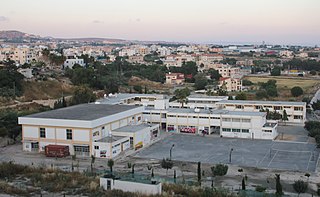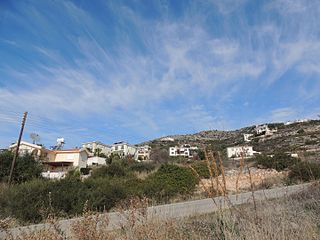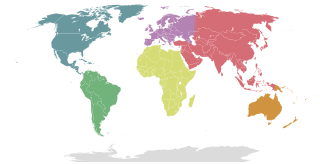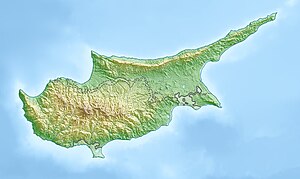
Antiphonitis – more correctly the Church of Christ Antiphonitis – is a domed church in Cyprus, in Kyrenia District, located in the mountains near the village of Kalograia. It is reached from the network of tracks and small roads in the area of the Herbarium and Agios Amvrosios. It is under the de facto control of Northern Cyprus.

Elena is a Bulgarian town in the central Stara Planina mountain in Veliko Tarnovo Province, located 42 km southeast of Veliko Tarnovo. It is the administrative centre of the homonymous Elena Municipality. The area is also a mountain resort, known for the typical local cuisine. As of December 2009, the town had a population of 5,665. It forms a terminal for the Gorna Oryahovitsa-Elena railway line.

Askas (Ασκάς) is a small village in Pitsilia region in the Nicosia District on the island of Cyprus. It is positioned 1000 metres above sea level on the north side of the Troodos mountain range, at the foot of Mount Papoutsa. Ioannis Constantinou is the president of the Community Council of Askas.

Geroskipou is a coastal village in Cyprus, east of Paphos. Its current population is approximately 7,000 and it is the second largest municipality in the Paphos District. Yeroskipou, with its remarkable five-domed Byzantine church of Agia Paraskevi, and its Folk Art Museum, is a popular tourist destination. It is known especially for the production of the confectionery "lokum". The town is the only place in the world which has protected geographical indication (PGI) for the popular dessert.

Agros is a village built on the Troödos Mountains, in the region of Pitsilia, in southwest Cyprus, which has built amphitheatrically among high mountains at an altitude of 1100 metres with a population of approximately 1,000. The village is located 45 minutes away from the cities of Nicosia and Limassol, 20 minutes from Troodos Square and 80 minutes from the international airports of Larnaca and Paphos.

The Nativity of Jesus has been a major subject of Christian art since the 4th century.

Kapilio is a small village in the Limassol region of Cyprus. It is located in the area famous for its Commandaria wine, built on a slight elevation in the valley of the Ambelikos river to the east of the Troodos mountain range.
Agia Varvara is a village located in the Nicosia District of Cyprus.The village is named after Saint Barbara. The village is located 22 km south from Nicosia and is at an altitude of 311 meters. The village is known for its many cultivated and barren pieces of land. The hosts the Church of Agia Varvara, the Chapel of Agia Paraskevi, Chapel of Agios Nektarios and the Chapel of Holy Cross.
Diorios or Dhiorios is a village in the Kyrenia District of Cyprus, 2 km west of Myrtou. It is under the de facto control of Northern Cyprus. Diorios is the second largest administrative area in the district of Kyrenia. Its administrative limits reach to the southern Nicosia-Kyrenia border. Most of the administrative area of the village is covered by dense pine forest, while in other areas sparsely-vegetated land allows for the cultivation of cereals and carob and olive trees. The surrounding forest occupies an area of 8,400 acres, or 1,124.4 hectares. The village itself covers an area of 27,587 acres, or 36.9 square miles.

Agios Sozomenos is a deserted village in the Nicosia District of Cyprus, close to the Green Line and near Potamia. It is located at the confluence of the Alikos river with the Gialias, the second-longest river of Cyprus.
Fterikoudi is a village in the Nicosia District of Cyprus, located 4 km north of Palaichori Morphou.

Kouka is a small village in the Limassol District of Cyprus, in the foothills of the Troodos Mountains on the western slopes of the Kouris Valley. The village is 2 km south of Pera Pedi on the road to Sylikou, and it is home to the church of Timios Stavros.

Vasa Kellakiou is a village in the Limassol District of Cyprus, located 5 km northwest of Asgata.
Polemi is a village in the Paphos District of Cyprus.

Tremithousa is a village in the Paphos District of Cyprus, located 7 km north of Paphos. Tremithousa is located 294 m above sea level. Tremithousa is located near Mesa Chorio and Mesogi Village. Tremithousa receives an average annual rainfall of about 520 millimeters; vines of winemaking varieties, vegetables, cereals, forage plants, citrus, almond, and walnut trees, and legumes are cultivated in the region. The village has a reputation for the aromatic and tasty honey that it produces. Tremithousa connects in the north to the monastery of Agios Neofytos, in the northeast with the village of Tala, and in the east with the main road of Tsada – Polis.
Gialia is a village in the Paphos District of Cyprus, located 11 km northeast of Polis Chrysochous. Prior to 1974, the village was inhabited by Turkish Cypriots.
Mavranaioi is a village and a community of the Grevena municipality. Before the 2011 local government reform it was a part of the municipality of Theodoros Ziakas, of which it was a municipal district and the seat. The 2021 census recorded 223 residents in the community. The community of Mavranaioi covers an area of 37.934 km2.

Ayios Kassianos is a Neighbourhood, Quarter, Mahalla or Parish of Nicosia, Cyprus and the church situated therein after which the Quarter is named. It is Άγιος Κασσιανός in Greek and Aykasyano in Turkish and also has the historic name Kafesli . At the last Census (2011) it had a population of 315,.

Christianity in Cyprus is the largest religion in the country, making up 78% of the island's population. The largest Christian denomination is the Greek Orthodox Church, while the rest are smaller communities of Anglicans, Roman Catholics, Latin Christians, Maronites, Armenian Apostolics, and Greek Evangelicals.















